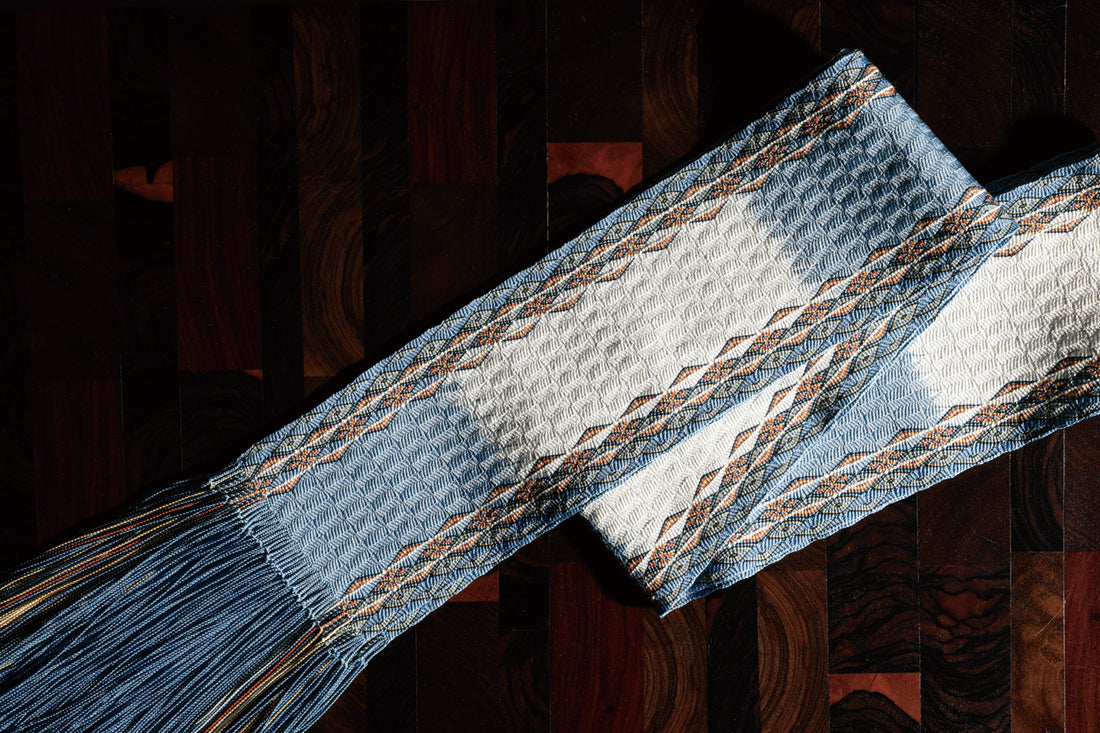Kumihimo is deeply involved in various fields such as religion, ceremonies, performing arts, clothing, and furnishings in Japan.
Full-fledged development of Kumihimo began in the Asuka and Nara periods, when continental Chinese culture was introduced through trade.
Asuka/Nara period
The Vitality of Beginnings transmitted to Tenpyo period Japan
Kumihimo, which was introduced from the continental China, is thought to have taken root in Japan during the Nara period. Braids such as Nara-gumi, Sasanami-gumi, Kara-kumi, and Anda-gumi are preserved in Nara's Shosoin Repository and Horyu-ji temples. Kumihimo of this period is characterized by its boldness and generous colors.

Heian period
Japanese Skill and Aesthetic braided into KUMIHIMO
In contrast to the Nara period, when people enjoyed the basic braiding methods, the Heian period pursued a more diverse range of expressions.
It was also during this period that he created new braids by synthesizing several previous techniques, and also developed the technique of tiered dyeing. It can be used as a cord used by aristocrats to hang their swords, cords for weapons, cords to seal sutra scrolls and emakimono illustrated handscrolls, and cords for hanging amulets around the neck.


Kamakura/Muromachi period
Challenge to Creativity - For Deeper and More Complex KUMIHIMO making
In the Kamakura period, various new braids were created using the braid techniques that had been studied in the Heian period.
Kikko-gumi is a representative braid that was born in this era. It was widely used as a string for armor. In addition, the cords of the Saidaiji-gumi and Chionin-gumi have been placed in the bodies of the Buddha statues, and the KUMIHIMO remains to this today.
It seems that new braiding methods were barely invented in the Muromachi period, but the advanced techniques from the Kamakura period were inherited.


Edo Period
MONOZUKURI by Modern People; Rebirth and Innovation of Ancient Technology
It is worth mentioning that the main use of Kumihimo is as sageo. Sageo is a string attached to the sword, and is finished to approximately the same dimensions as today's obijime. For this reason, the various shapes of braids that existed before the Edo period were transformed into shapes suitable for the lower straps, and new braids were created.
The braiding style created in the Edo period includes Kainokuchi-gumi, Korai-gumi, and Jinaiki-gumi.
Also, the technique of ayadashi was born during this period. This is a technique to put out patterns and letters on the braid. Documents of the time tell us that various patterns were created in conjunction with Edo's chic culture.

After the Meiji era
Transformation to the Modern Age; The Continuum of Technology and Tradition
The demand for cords and bundled threads, which accounted for the majority of kumihimo products until the Edo period, suddenly disappeared with the ban on swords after the Meiji Restoration. Kumihimo merchants, who lost most of their jobs, found a way out in obi-jime, which was used to hold obi sashes for women's kimonos, which was gradually becoming mainstream at the time. Through the Meiji period, Otaikomusubi was established for women's kimono, and braided sashes became a nessessary item for kimono, and sashes came to occupy the majority of kumihimo products.



